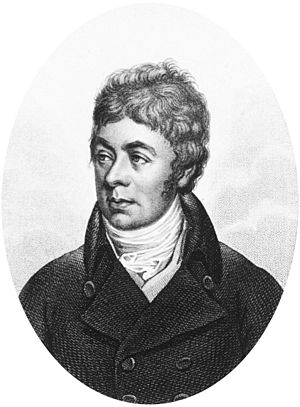George Shaw (biologist) facts for kids
Quick facts for kids
George Shaw
|
|
|---|---|
 |
|
| Born | 10 December 1751 Bierton, Buckinghamshire
|
| Died | 22 July 1813 (aged 61) |
| Nationality | English |
| Alma mater | Magdalen College, Oxford (MA) |
| Scientific career | |
| Fields | Botany, Zoology |
| Institutions | University of Oxford |
George Kearsley Shaw (born December 10, 1751 – died July 22, 1813) was an important English scientist. He was a botanist, meaning he studied plants. He was also a zoologist, which means he studied animals. Shaw is especially known for being one of the first scientists to describe the unique platypus from Australia.
Contents
About George Shaw
George Shaw was born in a place called Bierton in England. He went to Oxford University and earned his master's degree in 1772. After his studies, he first worked as a doctor.
In 1786, Shaw started teaching botany at the University of Oxford. He loved studying plants and sharing his knowledge.
He helped create the Linnean Society in 1788. This was a new group for scientists who studied nature. In 1789, he also became a member of the Royal Society. This is a very old and respected science group in England.
Working at the British Museum
In 1791, George Shaw began working at the British Museum. He became an assistant in the natural history department. Later, in 1806, he became the main keeper of that department.
When he started, he found that many of the old animal and plant samples were in very bad condition. These items had been given to the museum by a collector named Hans Sloane. Some of the stuffed animals and birds were so old and damaged that they had to be thrown away. George Shaw worked hard to organize and care for the museum's collection.
After George Shaw passed away, his assistant, Charles Konig, took over his role at the museum.
What George Shaw Wrote
George Shaw wrote many important books about animals and plants. He helped people learn about new species from around the world.
Describing the Platypus
One of his most famous works was "Zoology of New Holland" (1794). In this book, he gave some of the first English descriptions of Australian animals.
He was also one of the first scientists to study a platypus. This amazing animal has a duck-like bill, lays eggs, and lives in water. Shaw published the first scientific description of the platypus in his book The Naturalist's Miscellany in 1799.
Other Publications
George Shaw also described many new types of reptiles and amphibians. These are cold-blooded animals like snakes, lizards, frogs, and salamanders.
Some of his other important books include:
- Musei Leveriani explicatio, anglica et Latina (1792–96). This book showed special items from the museum of Sir Ashton Lever.
- General Zoology, or Systematic Natural History (1809–1826). This was a very large set of books with 16 volumes. The last few volumes were finished by another scientist, James Francis Stephens.
- The Naturalist's Miscellany: Or, Coloured Figures of Natural Objects; Drawn and Described Immediately From Nature (1789–1813). For this book, he worked with an artist named Frederick Polydore Nodder, who drew and engraved the pictures.
When you see the abbreviation G.Shaw next to a species name, it means George Shaw was the scientist who first described that plant or animal.

